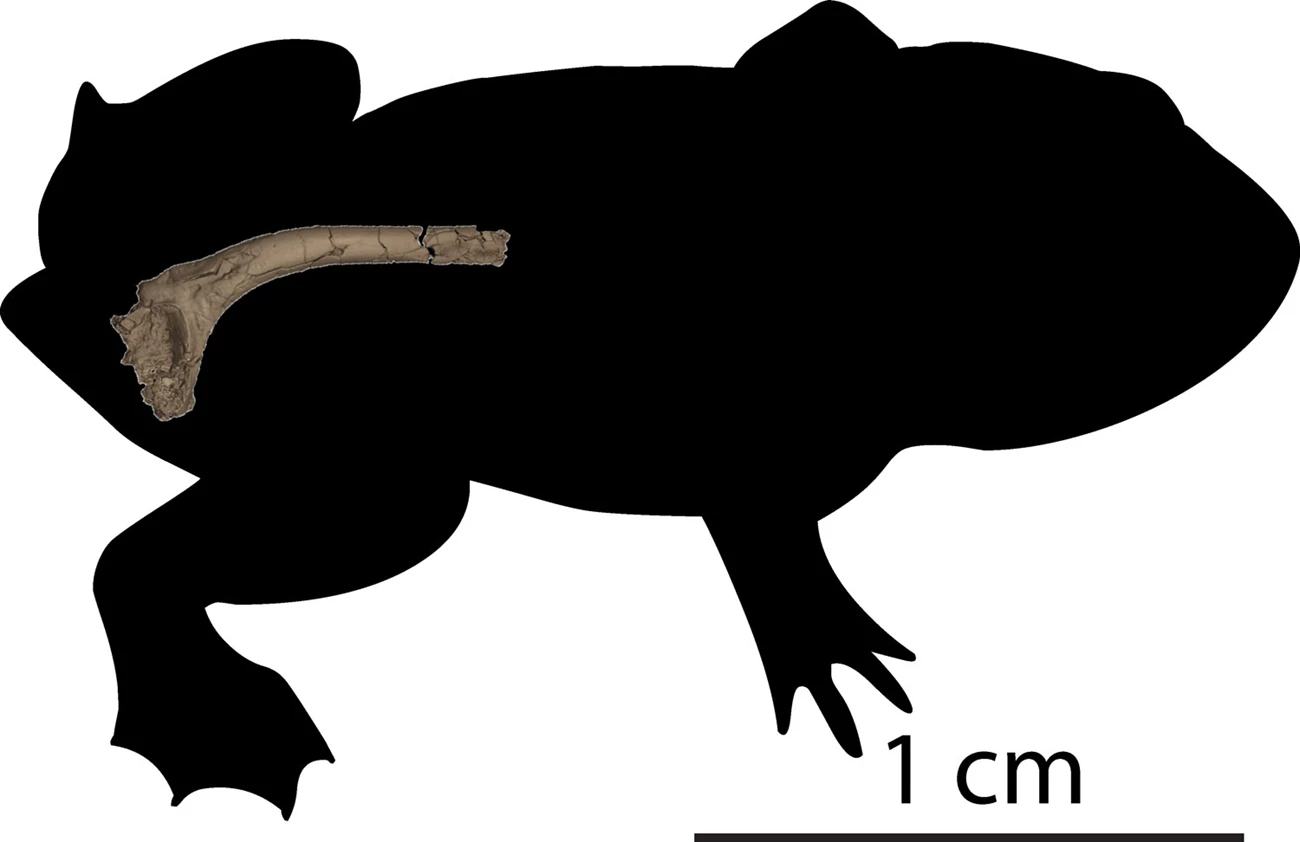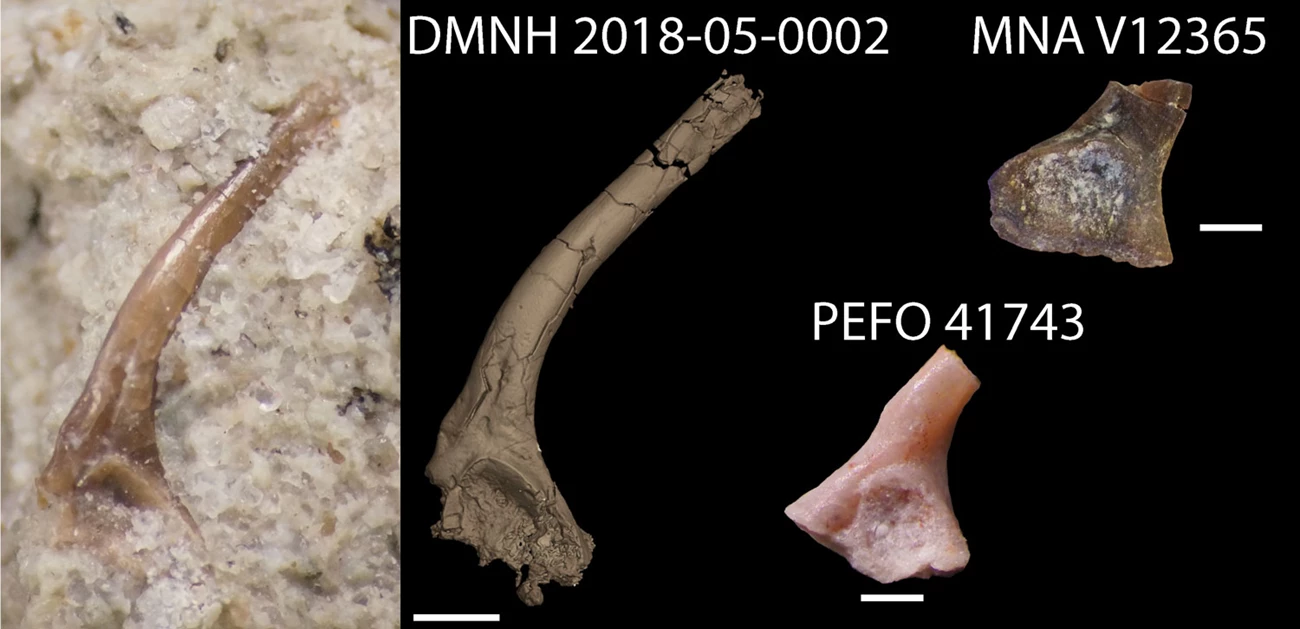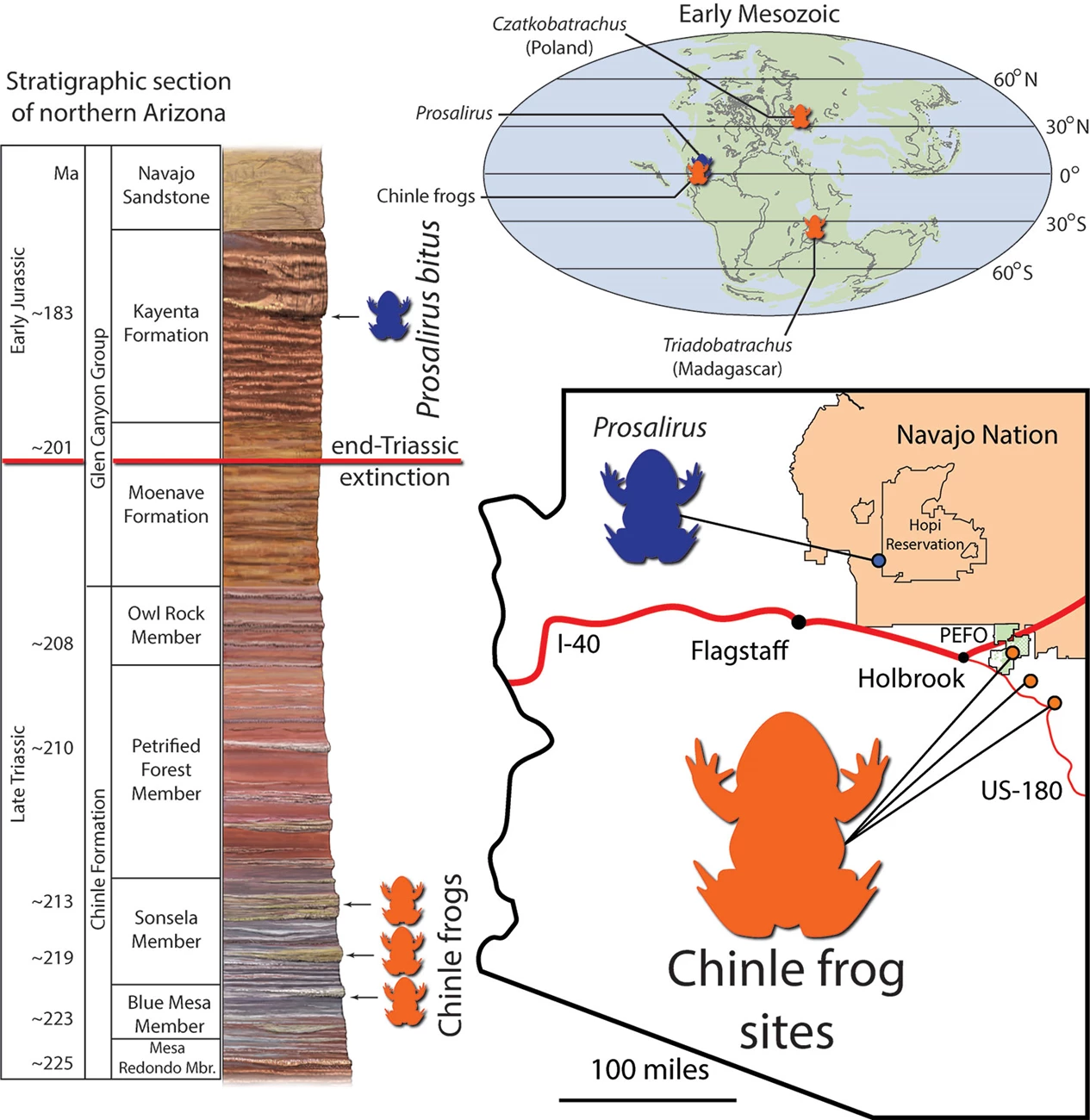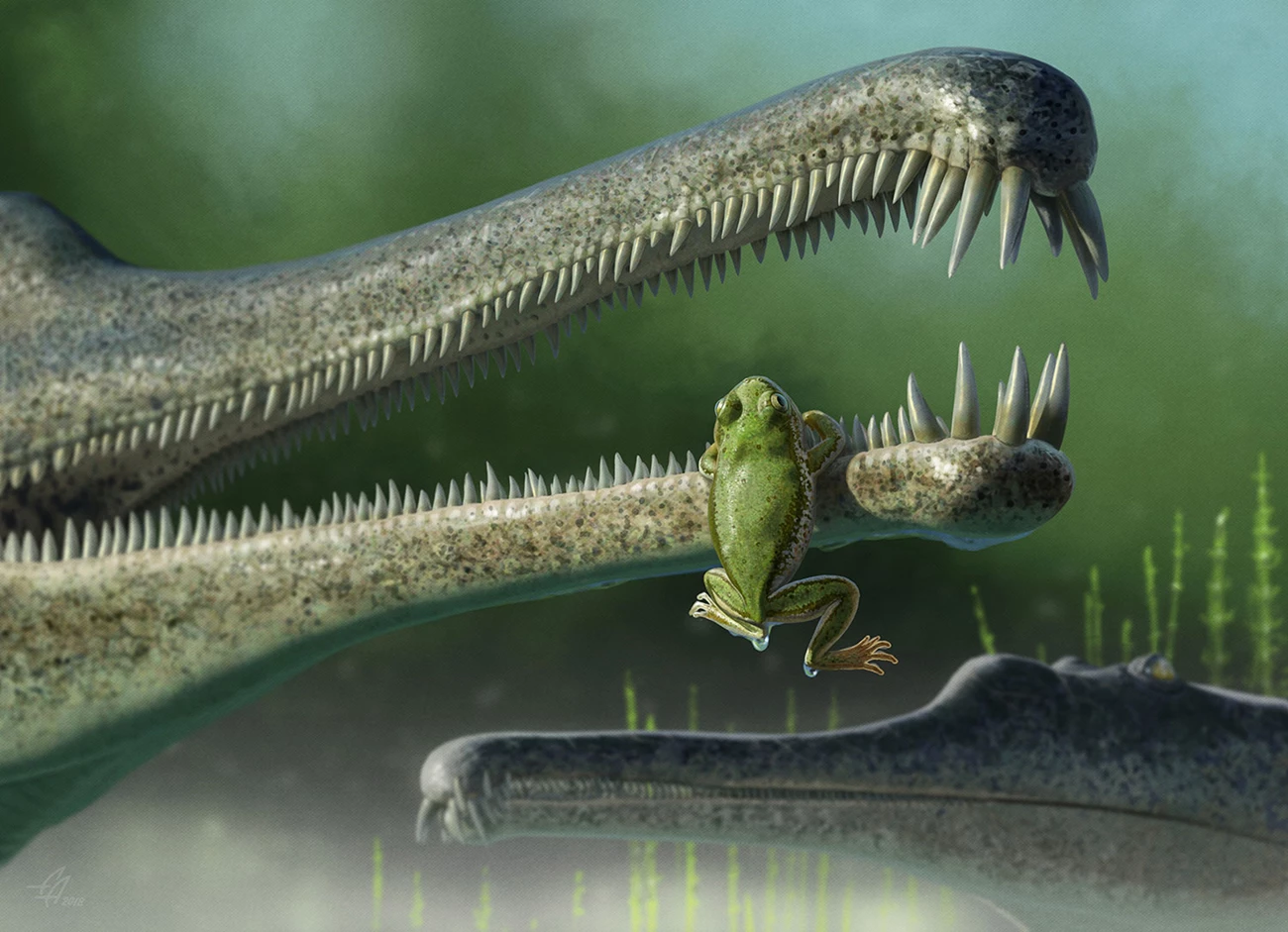Part of a series of articles titled Park Paleontology News - Vol. 11, No. 1, Spring 2019.
Article
Renewed emphasis on microvertebrate fossils recovers the oldest frogs in North America

Article by Dr. Adam D. Marsh, Lead Paleontologist,Petrified Forest National Park
The Late Triassic Chinle Formation (~228–208 Ma) and age-equivalent strata in the southwestern United States (Arizona, Utah, New Mexico, Colorado, Wyoming, and Texas) is well known for the relatively high diversity of vertebrate macrofossils representing medium-to-large-bodied groups such as the Phytosauria, Aetosauria, Metoposauridae, Rauisuchidae, and Dicynodontia (Long and Murry, 1995; Heckert and Lucas, 2002). These fossils have been somewhat easy to discover, excavate, prepare, and curate for more than 100 years (Parker, 2006) owing to their large size and the bentonitic, easily-eroded siltstones laid down by rivers, lakes, streams, and soils in the Late Triassic. However, relatively little research has been done on the microvertebrates of the Chinle Formation (but see Heckert, 2004; Kligman et al., 2017, 2018), leading to a wide gap in knowledge of the early evolution of modern small-bodied groups such as frogs.

Silhouette by Nobu Tamura via phylopic.org used under the Creative Commons Attribution 3.0 Unported license (https://creativecommons.org/licenses/by/3.0/).
Until recently, the only amphibians known from the Chinle Formation belonged to the Metoposauridae, a long-extinct group of large-bodied, flat-headed temnospondyls that were ambush predators in Late Triassic lakes and rivers. Metoposaurids had incredibly robust skulls, pectoral girdles, and vertebral intercentra and are among the most common fossils found in the Chinle Formation of Arizona. The earliest members of Lissamphibia, a monophyletic group that includes the modern amphibian lineage (frogs, salamanders, and caecilians; Marjanović and Laurin, 2007), were small-bodied and far less abundant; two stem-frogs are known from the Early Triassic high latitudes of what is now Poland and Madagascar (Piveteau, 1936; Rage and Roček, 1989; Evans and Borsuk−Białynicka, 1998, 2009; Ascarrunz et al., 2016) and a putative stem-caecilian has recently been reported from the Late Triassic of Colorado (Pardo et al., 2017), and the next youngest members of those groups are known from the Early Jurassic Kayenta Formation on the Navajo Nation (Jenkins and Walsh, 1993; Shubin and Jenkins, 1995). For frogs, this results in a gap in the fossil record of approximately 60 million years. Fortunately, new fossils from Petrified Forest National Park (PEFO) and sites from a neighboring ranch and St. Johns, Arizona are starting to fill that gap.

Last summer, a collaborative team from Virginia Tech (VT) and PEFO was conducting fieldwork on a ranch adjacent to the park with permission from the landowner and repository agreement with the Perot Museum of Nature and Science (DMNH) in Dallas, Texas. The crew was quarrying at a known microfossil locality (~213 Ma; Ramezani et al., 2011) by excavating small blocks of rock (<1 kg), splitting them, searching for microfossils with a hand lens, and wrapping intriguing fossiliferous samples in tissue paper. After several days, the VT crew departed with several anatomically interesting samples needing closer inspection, including a frog ilium (Figure 1). The shape of frog ilia is characteristic of that group and is unlike that of metoposaurids or other small vertebrates. While that specimen was being CT scanned for detailed study, the research team discovered more frog ilia from slightly older strata (221-219 Ma; Atchley et al., 2013; Ramezani et al., 2014) via screen washing sediment at PEFO and at the collections from the Placerias Quarry housed at the Museum of Northern Arizona (MNA) in Flagstaff (Figure 2). Together, these new frog fossils belong to the group Salientia (modern frogs and their closest evolutionary ancestors) and represent both the earliest frogs in North America and the earliest frogs from the equatorial region of Pangea (Stocker et al., 2019). The new fossil frogs are more similar to the younger Early Jurassic fossil frog Prosalirus bitis than older Early Triassic frogs, suggesting that frogs were not extirpated from the region during the drying event and hypothesized mass extinction at the end of the Triassic Period (Figure 3; Figure 4; Atchley et al., 2013; Blackburn et al., 2013; Nordt et al., 2015).

New fossil discoveries are not only important for understanding the early evolution of modern animal groups like lissamphibians and providing examples of the interaction between changing climates and ecosystems, they can emphasize the utility of federal-private partnerships in the National Park Service. Collaborations like these can bolster strengthen park science programs, collect empirical data for management decisions, and create interpretive content that has the ability to spread far beyond park and museum visitors. Working with outside researchers and other museum institutions, NPS units like Petrified Forest National Park provide the opportunity to explore new scientific spaces and reach audiences that are interesting in learning more about the fossil resources on their federal lands.

Art by Andrey Atuchin, used with permission.
The research article featured here can be read and downloaded for free. CT scan data are available. The project was funded by David B. Jones, the National Science Foundation, the Petrified Forest Museum Association, the Friends of Petrified Forest National Park, and the Virginia Tech Department of Geosciences
References
Atchley SC, Nordt LC, Dworkin SI, Ramezani J, Parker WG, Ash SR, Bowring SA. 2013. A linkage among Pangean tectonism, cyclic alluviation, climate change, and biologic turnover in the Late Triassic: the record from the Chinle Formation, southwestern United States. Journal of Sedimentary Research 83: 1147-1161.
Ascarrunz E, Rage C-C, Legreneur P, Laurin M. 2016. Triadobatrachus massinoti, the earliest known lissamphibian (Vertebrata: Tetrapoda) re-examined by µCT-scan, and the evolution of trunk length in batrachians. Contributions to Zoology 58: 201-234.
Blackburn TJ, Olsen PE, Bowring SA, McLean NM, Kent DV, Puffer J, McHone G, Rasbury ET, Et-Touhami M. 2013. Zircon U-Pb geochronology links the end-Triassic extinction with the Central Atlantic Magmatic Province. Science 340: 941-945.
Evans SE, Borsuk−Białynicka M. 1998. A stem-group frog from the early Triassic of Poland. Acta Palaeontologica Polonica 43: 573-580.
Evans SE, Borsuk−Białynicka M. 2009. The Early Triassic stem-frog Czatkobatrachus from Poland. Palaeontologica Polonica 65: 79-105.
Heckert AB. 2004. Late Triassic microvertebrates from the lower Chinle Group (Otischalkian-Adamanian: Carnian), southwestern United States. NMMNHS Bulletin 27: 1-170.
Heckert AB, Lucas SG. 2002. Upper Triassic stratigraphy and paleontology. NMMNHS Bulletin 21: 1-301.
Jenkins FA, Walsh DM. 1993. An Early Jurassic caecilian with limbs. Nature 365: 246-250.
Kligman BT, Parker WG, Marsh AD. 2017. First record of Saurichthys (Actinopterygii) from the Upper Triassic (Chinle Formation, Norian) of western North America. Journal of Vertebrate Paleontology 37: e1367304.
Kligman BT, Marsh AD, Parker WG. 2018. First records of diapsid Palacrodon from the Norian, Late Triassic Chinle Formation of Arizona, and their biogeographic implications. Acta Palaeontologica Polonica 63: 117-127.
Long RA, Murry PA. 1995. Late Triassic (Carnian and Norian) tetrapods from the southwestern United States. NMMNHS Bulletin 4: 1-254.
Marjanović D, Laurin M. 2007. Fossils, molecules, divergence times, and the origin of lissamphibians. Systematic Biology 56: 369-388.
Nordt LC, Atchley SC, Dworkin SI. 2015. Collapse of the Late Triassic megamonsoon in western equatorial Pangea, present-day American Southwest. GSA Bulletin 127: 1798-1815.
Pardo JD, Small BJ, Huttenlocker AK. 2017. Stem caecilian from the Triassic of Colorado sheds light on the origins of Lissamphibia. PNAS 114: E5389-E5395.
Parker WG. 2006. On the shoulders of giants: influential geologists and paleontologists at Petrified Forest National Park; pp. 9-13 in Parker WG, Ash SR, Irmis RB (eds.), A Century of Research at Petrified Forest National Park 1906-2006, MNA Bulletin 62, Flagstaff.
Piveteau J. 1936. Une forme ancestrale des Amphibiens Anoures dans Trias inférieur de Madagascar. Comptes Rendus de l’Academie des Sciences 102: 1607-1608.
Ramezani J, Hoke GD, Fastovsky DE, Bowring SA, Therrien F, Dworkin SI, Atchley SC, Nordt LC. 2011. High-precision U-Pb zircon geochronology of the Late Triassic Chinle Formation, Petrified Forest National Park (Arizona, USA): temporal constraints on the early evolution of dinosaurs. GSA Bulletin 123: 2142-2159.
Ramezani J, Fastovsky DE, Bowring SA. 2014. Revised chronostratigraphy of the lower Chinle Formation strata in Arizona and New Mexico (USA): high-precision U-Pb geochronological constraints on the Late Triassic evolution of dinosaurs. American Journal of Science 314: 981-1008.
Rage J-C, Roček Z. 1989. Redescription of Triadobatrachus massinoti (Piveteau, 1936) an anuran amphibian from the Early Triassic. Palaeontolographica Abteilung A 206: 1-16.
Shubin NH, Jenkins FA. 1995. An Early Jurassic jumping frog. Nature 377: 49-52.
Stocker MR, Nesbitt SJ, Kligman BT, Paluh DJ, Marsh AD, Blackburn DC, Parker WG. 2019. The earliest equatorial record of frogs from the Late Triassic of North America. Biology Letters 15: 20180922.
Last updated: April 8, 2019
